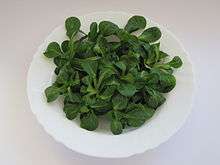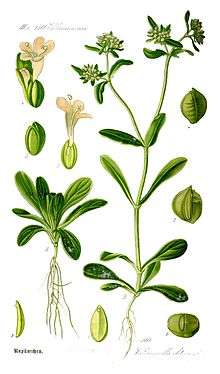Valerianella locusta
Valerianella locusta is a small annual plant that is eaten as a leaf vegetable. It has a characteristic nutty flavor, dark green color, and soft texture, and is popularly served as salad greens.[2] Common names include corn salad,[3] common cornsalad,[4] lamb's lettuce,[3] mâche[3] (/mɑːʃ/), fetticus,[3] feldsalat,[3] nut lettuce,[3] field salad, and rapunzel. In restaurants that feature French cooking, it may be called doucette or raiponce, as an alternative to mâche, by which it is best known.[5] In German-speaking Switzerland it is known as Nüsslisalat or Nüssler, terms that have been borrowed by the area's many English-speakers. It is typically served as a salad with chopped hard-boiled eggs and crumbled bacon.
Description
Corn salad grows in a low rosette with spatulate leaves up to 15.2 cm long.[3] It is a hardy plant that grows to zone 5, and in mild climates it is grown as a winter green.
In warm conditions it tends to bolt to seed,[6] producing much-branched stems with clusters (cymes) of flowers. The flowers have a bluish-white corolla of five fused petals, 1.5 to 2 mm (0.06 to 0.08 in) long and wide, and three stamens. Underneath the flowers is a whorl of bracts. Fertilized flowers produce achenes with 2 sterile chambers and one fertile chamber.[7][8][9]
Distribution and habitat
Corn salad grows wild in parts of Europe, northern Africa and western Asia.[10] In Europe and Asia it is a common weed in cultivated land and waste spaces. In North America it has escaped cultivation and become naturalized on both the eastern and western seaboards.[11]
As a cultivated crop, it is a specialty of the region around Nantes, France, which is the primary producer of mâche in Europe.[12]
History
Corn salad was originally foraged by European peasants until Jean-Baptiste de La Quintinie, royal gardener of King Louis XIV, introduced it to the world.[13] It has been eaten in Britain for centuries and appears in John Gerard's Herbal of 1597.[14] It was grown commercially in London from the late 18th or early 19th century and appeared on markets as a winter vegetable, but it only became available in modern supermarkets there in the 1980s.[15] American president Thomas Jefferson cultivated mâche at his home, Monticello, in Virginia in the early 1800s.[12]
The common name corn salad refers to the fact that it often grows as a weed in wheat fields.[14] (The European term for staple grain is "corn".) The Brothers Grimm's tale Rapunzel may have taken its name from this plant, as the eponymous character is named for the "salad" which her father has come into the sorceress' garden to steal. 'Rapunzel' is one of the German terms for corn salad.
Nutrition
Like other formerly foraged greens, corn salad has many nutrients, including three times as much vitamin C as lettuce, beta-carotene, B6, iron, and potassium. It is best if gathered before flowers appear.[16]
| Nutritional value per 100 g (3.5 oz) | |
|---|---|
|
3.6 g | |
|
0.4 g | |
|
2 g | |
| Minerals | Quantity %DV† |
| Potassium |
10% 459 mg |
| Sodium |
0% 4 mg |
| |
|
†Percentages are roughly approximated using US recommendations for adults. Source: | |
| Wikimedia Commons has media related to Valerianella locusta. |
| Wikispecies has information related to Valerianella locusta |
References
- ↑ "The Plant List".
- ↑ "Valerianella locusta". Missouri Botanical Garden.
- 1 2 3 4 5 6 7 "Valerianella locusta". Floridata.
- ↑ "BSBI List 2007". Botanical Society of Britain and Ireland. Archived from the original (xls) on 2015-01-25. Retrieved 2014-10-17.
- ↑ "Mâche". Larousse Cuisine.
- ↑ Plants for a Future: Valerianella locusta
- ↑ "Valerianella locusta". E-Flora BC: Electronic Atlas of the Flora of British Columbia.
- ↑ "Taxon Profile: Valerianella locusta". Flora of New Zealand. Missing or empty
|url=(help) - ↑ "Taxon Profile: Valerianella". Flora of New Zealand.
- ↑ "Valerianella locusta". Germplasm Resources Information Network (GRIN). Agricultural Research Service (ARS), United States Department of Agriculture (USDA). Retrieved 2017-12-18.
- ↑ "Valerianella locusta". Natural Resources Conservation Service PLANTS Database. USDA.
- 1 2 "History of Mâche". Epicroots.
- ↑ Organic Gardening Magazine, August–September 2007
- 1 2 Ayto, John, ed. (2002). An A-Z of Food and Drink. Oxford University Press.
- ↑ T. W. Sanders (1917), Vegetables and Their Cultivation, London: W. H. & L. Collingridge Limited
- ↑ Bender, David A., ed. (2005). Dictionary of Food and Nutrition. Oxford University Press.
Sources
![]()

